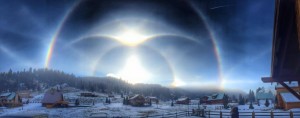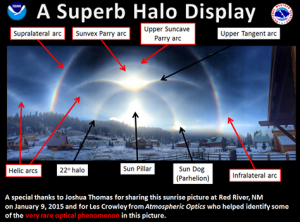Several of my meteorologists friends posted this image on Facebook yesterday from NWS Amarillo (picture by Joshua Thomas on 1-9-2015 in New Mexico):
This is one of the best pictures of atmospheric optics I have seen, particularly for an area outside of Antarctica. Atmospheric optics is the study of how light moves through water drops or ice crystals. Of course the most common optical effect is a rainbow, which is caused by light entering a raindrop, bouncing off the back surface and dispersing into different colors as it moves through the drop. But there are even more effects caused by light moving through ice crystals, since the crystals have a lot more variety in shape and size than raindrops. This image shows many of the ice crystal phenomena, which are identified in the figure below from NWS La Crosse. Of the effects seen in the picture, the ones you are most likely to have seen are the sun dogs or “parhelia” and the 22 degree halo. Some of these phenomena have been used as folk weather predictions, such as “a ring around the moon means rain within 48 hours”. That’s because their causes are related to where moisture is in the atmosphere and typical patterns of clouds and weather associated with fronts and storms.
If you are interested in learning more about some of these phenomena, Wikipedia has a good article about the most common types of optical displays. Another web site with some excellent pictures and brief descriptions is at https://atoptics.co.uk/. Who knows what you will see in the sky if you keep looking?

